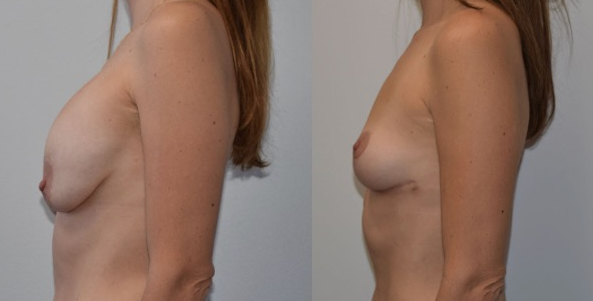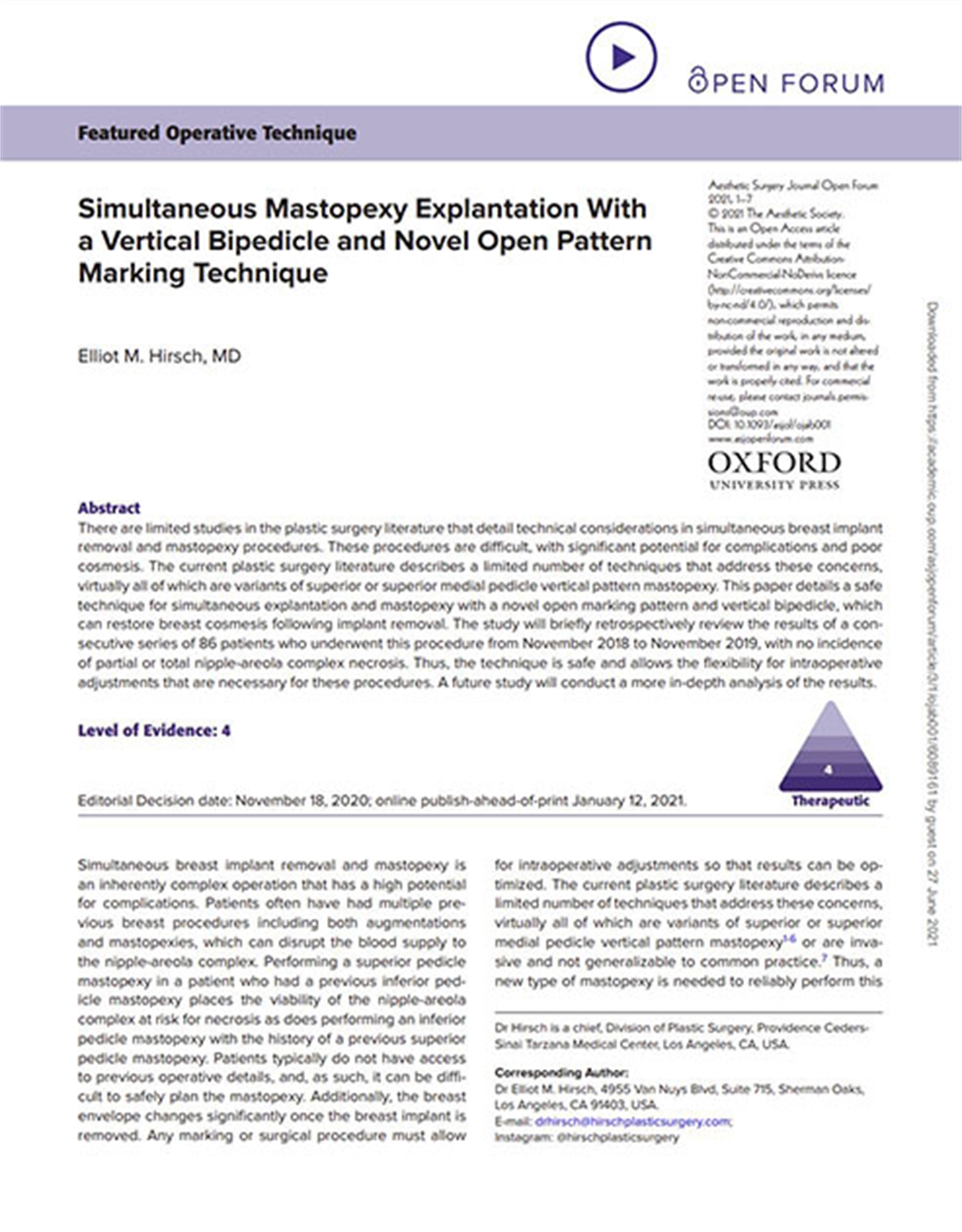Breast Implant Removal Los Angeles

Dr. Hirsch is one of the most well known and experienced surgeons for breast implant removal in Los Angeles. He has performed over 1000 explants, with and without mastopexy. As an expert breast implant removal surgeon in Los Angeles, Dr. Elliot Hirsch helps patients remove implants for various reasons, including breast implant complications or concerns about breast implant illness. Dr. Hirsch treats patients from Los Angeles and the surrounding areas including Bakersfield, Fresno, San Diego, and all throughout California and the Unites States, ensuring that you have access to top-tier care no matter where you’re located.
About the procedure
For many reasons such as breast implant rupture, capsular contracture, other symptoms of breast implant illness, or simply not wanting implants anymore, Los Angeles breast implant removal patients may choose to undergo removal of their breast implants. Dr. Hirsch performs a total capsulectomy in all cases, en bloc whenever possible, to remove the breast implants and their capsules. Often, there is a lot of skin remaining after the implants are removed because the implants cause the skin to stretch. To remove the extra skin and reshape the breasts, a breast lift (mastopexy) can be performed at the same time as the procedure. Other procedures such as liposuction and fat transfer can be performed at the same time as well to improve breast appearance.
View Images of Breast Implant Removal without Breast Lift
In general, there are two different types of breast lifts that can be performed for our breast implant removal patients: the circumareolar (or internal) breast lift and the full breast lift. The circumareolar lift is performed through the areola while the full breast lift is done through an anchor-pattern incision. Through the hundreds of these procedures that he’s performed, Dr. Hirsch has developed his own technique for breast implant removal, en bloc capsulectomy, and mastopexy, and has published it in the Aesthetic Surgery Journal online. It’s available at the link below:
Read at National Library of Medicine
The video below shows Los Angeles breast implant removal specialist Dr. Elliot Hirsch performing an implant removal, total (en bloc) capsulectomy, and a breast lift.
Breast implant removal, en bloc capsulectomy, and breast lift
If no lift is performed, the breast implants and capsules can often be removed through the same incision that was used for the breast augmentation, which minimizes new scarring. Most often, this is done through the inframammary fold incision. If a lift is performed as well, the implants and capsules can be removed through the lift incisions, which also limits scarring.
Most patients who have their breast implants removed with/without a lift say that they feel a soreness, like after working out in the gym. This usually lasts a few days and is much better after a week or so. After two weeks, most patients are able to resume their regular activities without much difficulty. Dr. Hirsch recommends wearing a soft, supportive sports bra or other similar bra without underwire during this healing period. Drains are usually for one week post-operatively.
If desired, cultures can be taken and tissue may be sent for pathology. Implants can usually be returned to patients, although this is subject to the facility policy.
Frequently Asked Questions
Breast Implant Removal in Los Angeles
What is the difference between en bloc and total capsulectomy?
In general, en bloc capsulectomy, otherwise known as “total complete capsulectomy” refers to removal of the breast implant scar tissue capsule while it remains around the breast implant. Total capsulectomy refers to a removal of the capsule, but not necessarily while it remains around the implant. Please review our en bloc capsulectomy vs. total capsulectomy page for additional information.
How much does breast implant removal cost in Sherman Oaks?
The cost of breast implant removal varies depending on the complexity of the surgery and any additional procedures like a breast lift. Contact our office in Sherman Oaks for a personalized consultation and pricing information.
How long is the recovery after breast implant removal?
Recovery after breast implant removal usually takes 2-4 weeks. Patients may experience swelling and discomfort initially, but most return to normal activities within a few weeks. Drains may be used, and following post-operative care instructions is important for optimal recovery.
What are the risks of breast implant removal surgery?
Breast implant removal is generally a safe procedure, but as with any surgery, there are risks such as infection, bleeding, scarring, and changes in breast sensation. Dr. Hirsch, based in Los Angeles, carefully assesses each patient to minimize these risks.
Can breast implants be removed and replaced in the same surgery?
Yes, in many cases, breast implants can be removed and replaced during the same surgery. Dr. Hirsch will assess your specific situation and discuss whether replacement or alternative options like fat grafting are right for you.
How do I know if I need a breast lift after implant removal?
If your implants have caused significant stretching of the breast skin, a breast lift may be recommended after implant removal. Dr. Hirsch will evaluate your breast tissue during the consultation and recommend the best approach to achieve a natural and youthful appearance.
What is the breast implant capsule?
The breast implant capsule is a layer of scar tissue that naturally forms around the implant. This is different from the silicone shell of the implant. Dr. Hirsch, a plastic surgeon in Sherman Oaks, performs a total capsulectomy, removing the capsule and implant together to minimize exposure to any remaining silicone.
My implants are big and I am worried that my breasts will be saggy if the implants are removed. What can be done to help?
Large implants can stretch the skin, and after removal, breasts may look saggy or deflated. Dr. Hirsch often recommends a breast lift to reshape the breasts, tighten the skin, and reposition the nipple for the best appearance. The type of lift will depend on your breast size and the amount of sagging.
What is “breast implant illness?”
Breast implant illness describes symptoms some women experience that they believe are linked to their implants. The condition is still being studied. Dr. Hirsch has discussed it in detail with Dr. Yehuda Shoenfeld in a podcast series.
Dr. Yehuda Shoenfeld
• Part 1: Breast Implant Illness – Separating Fact From Fiction
A Patient Story w/ Lauren
• Part 2: Breast Implant Illness – Separating Fact From Fiction
A Patient Story w/ Lorena
• Part 3: Breast Implant Illness – Separating Fact From Fiction
What is breast implant associated ALCL? Am I at risk?
Breast implant-associated Anaplastic Large Cell Lymphoma (BIA-ALCL) is a rare cancer linked to textured implants. Symptoms include swelling and fluid buildup in the breast. Treatment usually involves removal of the implant and capsule, and sometimes chemotherapy.

Call for a consultation
Schedule online today »

